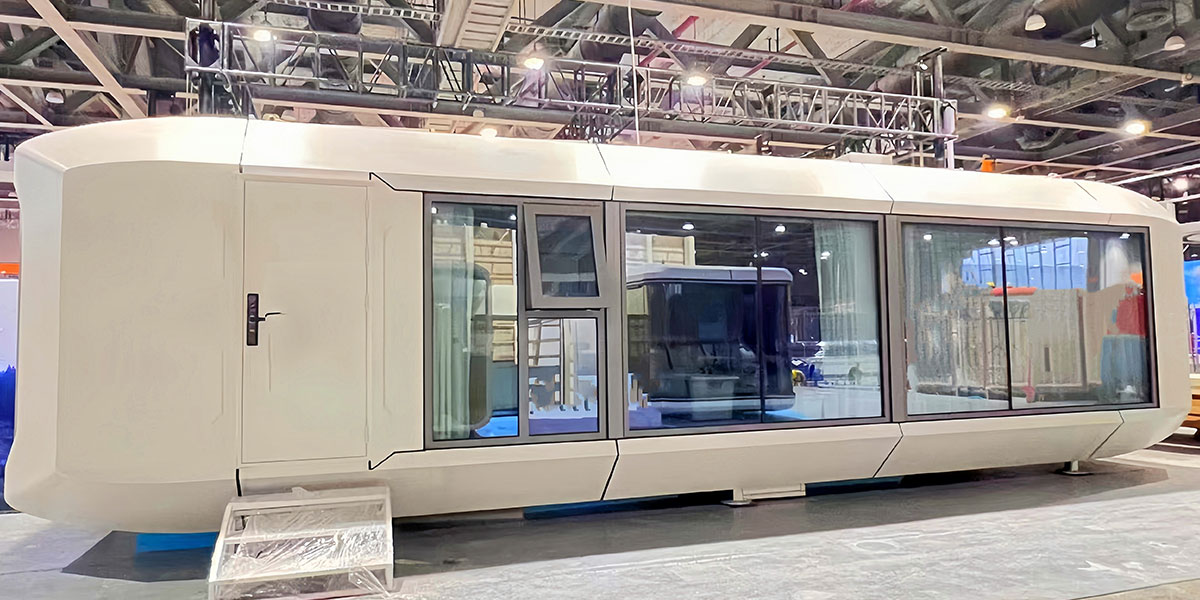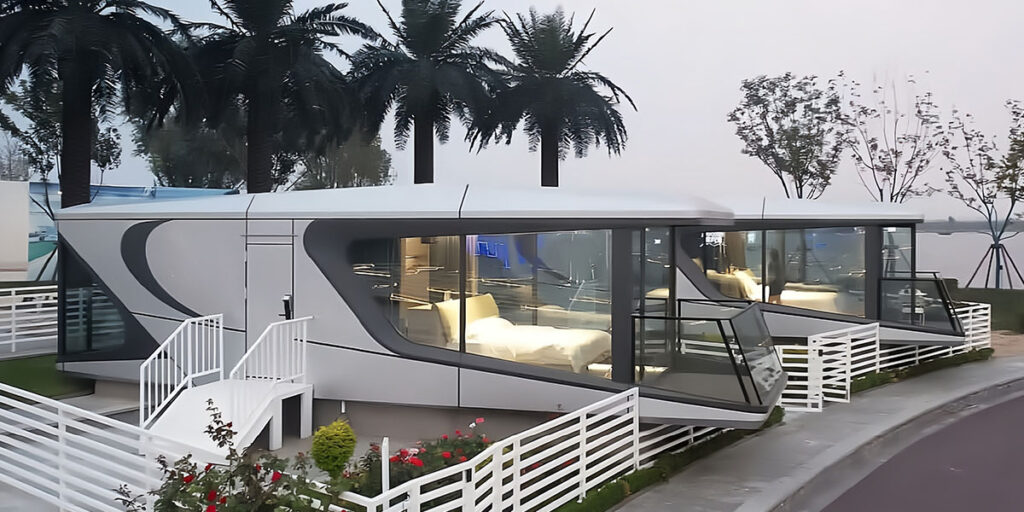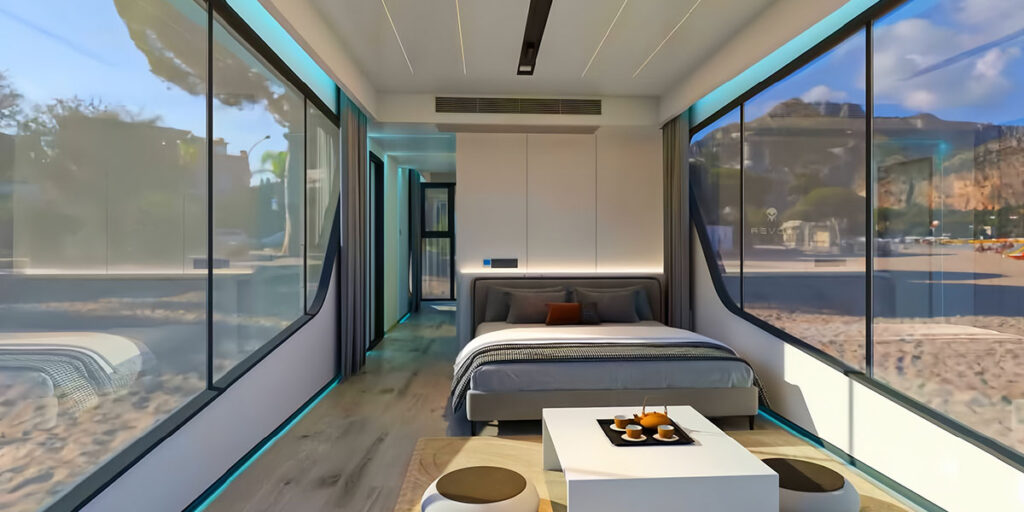
07 Jul 10 Expert Tips for Choosing Your Ideal 3-Bedroom Capsule House
Table of Contents
Choosing a capsule house 3 bedroom isn’t just about picking a roof over your head—it’s about finding a space that fits your life. Whether you’re dreaming of a cozy retreat or a modern family home, these compact gems can offer more than meets the eye. Why are more people turning to options like a 3 bedroom container home?
They’re eco-friendly since they repurpose old shipping containers, cutting down on waste.
They’re budget-friendly, saving you money on construction.
They’re durable, built to withstand tough conditions.
They’re flexible, letting you customize the layout to match your lifestyle.
With so many benefits packed into a capsule home, it’s no wonder they’re reshaping how we think about modern living. Ready to explore your options? Let’s dive in!
Key Takeaways
Think about how much space you need. Decide how each room will be used to make the layout work well.
Pick a good location. Being close to schools, work, or parks makes your home more useful and valuable.
Plan your budget carefully. List what you really need to avoid spending too much.
Choose energy-saving features. Things like solar panels can lower your utility bills later.
Design your home to be flexible. Modular designs let your house change as your needs change.
Key Considerations for a Capsule House 3 Bedroom
Assessing Space and Layout Needs
When picking a 3-bedroom capsule house, think about your needs. How will you use each room? Will one be an office, or are all bedrooms for sleeping? A smart layout can make small spaces feel bigger and more useful.
Open floor plans are common in these homes. They remove extra walls, connecting the kitchen, living, and dining areas. This design saves space and makes the home feel roomy. Clever storage ideas, like stairs with drawers or hidden compartments, also help a lot.
Good airflow and temperature control are very important too. Poor air and heat can hurt sleep and focus. Make sure your home has proper vents and insulation to avoid this.
Key Findings | What It Means for Capsule Homes |
|---|---|
Hot temps (28 °C) and bad airflow harm sleep. | Homes need good air systems for better sleep. |
People felt air quality got worse with less airflow. | Ventilation is key for healthy air in small spaces. |
Work got harder after sleeping in hot, stuffy rooms. | Good airflow and cooling improve daily performance. |
Evaluating Location and Accessibility
Where you place your capsule house matters a lot. Is it near schools, work, or buses? Easy access is important, especially if you might sell it later.
Studies show that homes with good access features sell for more. Parks or green areas nearby can also raise value and improve health. So, pick a spot that’s both handy and pleasant.
Methodology | Findings | Effect on Home Value |
|---|---|---|
Adding access data to price models | Better price predictions | Shows location is key for value |
Studying green spaces with AI tools | Parks add beauty and health perks | Green space value depends on location |
Understanding Functionality and Purpose
What will your capsule house be used for? Is it for family, renting, or vacations? Your answer will guide the design and features of your home.
For a family home, you might want soundproof walls and privacy. A vacation home could focus on outdoor areas like decks or gardens. Built-in furniture, like fold-up beds, can save space and add flexibility.
Design Feature | How It Helps | Example Use |
|---|---|---|
Window Placement | Adds light and connects indoors to outdoors | Big glass doors for bright spaces |
Open Floor Plans | Makes small spaces feel larger | Joining containers for big rooms |
Rooftop Gardens | Adds insulation and outdoor space | Urban gardens on roofs |
Built-in Furniture | Saves space and adds function | Fold-up beds for guest rooms |
By matching your home’s design to its purpose, you’ll create a space that fits your life perfectly.
Popular Layouts for 3 Bedroom Container Homes

Open-Concept Designs
Open-concept layouts are popular for 3 bedroom container homes. They remove extra walls, making spaces feel open and connected. This design makes small homes seem bigger and more welcoming. Picture a home where the kitchen, dining, and living areas flow together. It’s great for families who enjoy spending time together or hosting friends.
Container homes are strong, allowing for creative open layouts. Designers use roof beams to create wide spaces, like a 24-foot-wide living room in the Foster Residence. Breezeways or porches can connect indoor and outdoor areas, adding to the open feel. Bedrooms or offices can fit into separate containers while keeping shared spaces open.
Tip: Open-concept layouts save energy by improving airflow and natural light. They’re also eco-friendly and reduce energy costs.
Split-Level Configurations
Split-level layouts bring a fresh look to 3 bedroom container homes. By stacking or shifting containers, you can create separate zones for living, sleeping, and working. This design is perfect for keeping noisy areas away from quiet ones.
Imagine a home with a raised master bedroom overlooking the living space below. A small staircase or ladder could connect the levels. Split-level designs use vertical space well, giving your home a modern and stylish vibe. They also work great on sloped or uneven land where flat layouts might not fit.
Note: Split-level layouts add privacy and comfort, especially for families or shared homes. They’re a smart choice for homes with multiple people.
Compact and Efficient Floor Plans
Compact layouts focus on using every bit of space wisely. These designs make sure each area serves a purpose. In a 3 bedroom container home, this could mean combining storage with furniture or using rooms for multiple purposes.
Research shows compact layouts improve satisfaction and energy use. Designers plan layouts carefully, checking how well they meet people’s needs. This method balances comfort and efficiency, boosting happiness by 38.78% and energy savings by 11.18%.
Tip: Compact layouts save both space and money. By cutting out unneeded features, you can lower costs and focus on what matters most.
Whether you like open-concept, split-level, or compact layouts, there’s a design for you. Each option has its own perks, helping you build a home that fits your life.
Budgeting for Your Shipping Container Home
Comparing Base Costs and Add-Ons
Planning a budget for a 3-bedroom container home starts with knowing the basic costs and extras. Shipping containers can cost between $1,200 and $20,000, depending on their size and condition. But that’s just the start. You’ll also need to include costs for preparing the land, building a foundation, and getting permits.
Here’s a simple cost breakdown:
Expense Category | Average Cost Range |
|---|---|
Containers (1 bedroom, 1 bathroom) | $1,200–$20,000 |
Land leveling | $1,000–$3,500 |
Land excavation | $1,500–$6,500 |
Concrete foundation | $5–$37 per square foot |
Labor (General contractors) | 10% to 20% of job cost |
Building permits | $500–$2,000 |
Electrical wiring | $600–$2,300 |
Plumbing installation | $1,500–$15,000 |
HVAC system installation | $5,000–$12,000 |
Landscaping | $4.50–$12 per square foot |
Don’t forget about extras like insulation, soundproofing, or adding modular sections. These can make your home more comfortable but will raise the total cost.
Tip: Make a list of must-haves and nice-to-haves. This helps you focus your spending and avoid unexpected costs.
Exploring Financing Options
Paying for a capsule house might seem tricky, but there are ways to make it easier. Personal loans are common and offer good rates if you have a strong credit score. If your house isn’t on a fixed foundation, chattel mortgages could be faster, though they usually have higher interest rates.
FHA and VA loans are great for those who qualify. FHA loans work even if your credit isn’t perfect, while VA loans often don’t need a down payment, making them ideal for military members.
Here’s a quick comparison:
Financing Option | Interest Rates | Approval Times | Eligibility Criteria |
|---|---|---|---|
Personal Loans | Competitive rates based on credit score | Varies | Requires good credit score; compare lenders’ rates |
Chattel Mortgages | Higher rates due to personal property classification | Quicker | Used for mobile homes not on a permanent foundation |
FHA and VA Loans | Lower rates, accessible for bad credit (FHA) | Varies | FHA for general public; VA for service members, often no down payment |
Note: Compare different lenders to find the best deal. A little research can save you a lot of money over time.
Saving with Energy-Efficient Features
Adding energy-efficient features to your capsule house is smart for both the environment and your wallet. These homes already cost less to build than regular houses. Adding upgrades like solar panels or better insulation can save even more money.
Here’s how energy efficiency helps:
Container homes are cheaper to build than traditional houses.
Smart designs use space well, saving money and adding value.
Modular designs make building flexible and affordable for more people.
Think about adding solar panels, LED lights, or high-quality insulation. These features lower energy bills and make your home more comfortable.
Tip: Energy-efficient upgrades may cost more at first, but they save money in the long run with lower utility bills.
Enhancing Comfort and Privacy in a Capsule House

Insulation and Soundproofing Solutions
Living in a capsule house means comfort starts with good insulation. It keeps your home warm in winter and cool in summer. Advanced polyurethane foam is very effective. It saves energy and works six times better than older materials.
Soundproofing is also important, especially in noisy areas. Magnesium wall boards are a smart choice. They block noise well with their special design. A 6mm board can reduce noise by 29dB. Using 9mm boards with metal studs and rockwool can block over 42dB. This helps create a quiet and peaceful home.
Tip: Pick insulation and soundproofing that save energy and reduce noise. It’s a simple way to improve your home.
Strategic Use of Dividers and Partitions
Dividers and partitions are great for privacy in small homes. Open layouts are nice, but separate spaces are sometimes needed. Dividers can create a home office, playroom, or dressing area.
They also make your home look better. Folding screens, sliding panels, or bookshelves can work as dividers. They’re affordable, stylish, and help hide clutter.
Note: Dividers keep your home organized and private while staying open and airy.
Optimizing Natural Light and Ventilation
Natural light and airflow are very important in small homes. Big windows and glass doors bring in sunlight, making spaces feel larger. Skylights are great for rooms without outside walls.
Good airflow keeps the air fresh and prevents stuffiness. Ceiling fans or vents can improve circulation. This reduces the need for air conditioning and saves energy.
Tip: Use sunlight and airflow together for a bright, fresh, and comfy home.
Customization Options for Capsule Houses
Modular Extensions and Add-Ons
Capsule houses are super flexible, and modular add-ons make them even better. You can add rooms, a home office, or a rooftop deck. These changes let your home grow with your needs, like starting a hobby or expanding your family.
Modular systems have been used for years to create affordable homes. For example:
Evidence | Description |
|---|---|
After 1945, they provided quick, cheap housing. | |
Tennessee Valley Authority | Trailer-like homes became popular for low-cost living. |
Warren Chalk’s Capsule Houses | Swappable modules adjusted to people’s needs. |
These examples show how modular add-ons can turn your capsule house into a smart, useful space.
Tip: Begin with a small setup. Add more as your needs grow. Modular designs save money and space.
Personalizing Interiors with Design Choices
Your capsule house should feel like it’s truly yours. Personalizing the inside is the best way to make it special. From room layouts to tiny details, you can design it to match your style.
Here are some ideas to try:
Architectural Design: Arrange rooms and features to fit your taste.
Room Configuration: Change room sizes, window spots, and door placements.
Interior Design Variability: Pick floors, lights, and cabinets that suit your vibe.
Smart Home Technology: Use smart gadgets to control lights, heat, and security.
Customization Aspect | Description |
|---|---|
Exterior Modifications | Add porches, decks, or cool siding for a unique look. |
Interior Design Variability | Custom floors, lights, and cabinets make it feel personal. |
Adding your own touches makes your capsule house cozy and fun to live in.
Note: Small updates, like smart lights or cool furniture, can make a big difference in how your home feels.
Planning for Future Adaptability
Life changes, and your home should change with it. Flexible designs help your capsule house adjust to new needs. You might need extra bedrooms or a quiet office for remote work.
More families are living together now, showing why adaptability matters. Did you know multigenerational households grew by 271% from 2011 to 2021? Over 66.7 million adults now live in these homes.
Planning for flexibility makes your capsule house a long-term solution. Movable walls, modular add-ons, and foldable furniture are great ways to prepare for changes.
Tip: Plan ahead when designing your home. Thinking about the future now can save you money and effort later.
Maintenance and Durability of Capsule Houses
Picking Strong Materials
The materials you pick for your capsule house matter a lot. Good materials help your home last through bad weather and daily use. For example, Cor-ten steel is great for the main structure. It resists rust and doesn’t corrode easily. This steel is made to stay strong, even in tough conditions.
Using strong materials also gives other benefits:
Wind Resistance: Stands up to winds like Category 4 hurricanes (70 m/s).
Earthquake Resistance: Safe during earthquakes as strong as magnitude 9.
Sound Insulation: Blocks at least 55dB of noise for a quiet home.
Thermal Insulation: Works six times better than older materials to save energy.
Fire Resistance: Meets grade A safety standards for fire protection.
These materials may cost more at first, but they save money over time. They make your home stronger and easier to maintain.
Doing Regular Check-Ups
Taking care of your capsule house keeps it in good shape. Check your home often for rust or damage. Fixing small problems early stops bigger ones from happening. Homes made with Cor-ten steel are less likely to rust, but it’s still smart to check.
Design features can also help. Sloped roofs let water drain off, so it doesn’t cause rust. Placing your home in a dry spot or away from salty air can make it last longer.
Tip: Set reminders to check your home every few months. Small fixes now save big repairs later.
Protecting Against Weather
Weatherproofing helps your capsule house handle rain, wind, and sun. Start by looking for rust or leaks during regular checks. Use weatherproof coatings to keep moisture out. Anti-rust treatments and special paints add extra protection.
Here’s a simple guide to weatherproofing:
Technique | What It Does |
|---|---|
Find rust or damage before it gets worse. | |
Weatherproof Coatings | Keep your home safe from water and bad weather. |
Anti-Corrosive Treatments | Stop rust and make your home last longer. |
Sloped Roofs and Gutters | Move water away to prevent pooling and rust. |
Rust-Inhibiting Paint | Block moisture from reaching metal parts. |
Marine-Grade Epoxy | Add extra strength for extreme weather conditions. |
Using these methods will keep your capsule house strong and cozy for many years.
Picking the right 3-bedroom capsule house means balancing design and needs. Consider how the layout works for family, work, or relaxing. Strong materials are important for lasting quality and saving energy. Check local rules and plan your budget to avoid problems. A good 3-bedroom container home can be cozy, flexible, and stylish. Take your time, look at choices, and let it change how you live.
FAQ
1. How long does it take to build a 3-bedroom capsule house?
The time needed depends on the design and features. Most homes take 2-4 months to finish. Prefab designs are quicker, but custom ones take more time.
Tip: Hire skilled builders to speed up work and avoid delays.
2. Are capsule houses safe during extreme weather?
Yes, they are safe if built with strong materials like Cor-ten steel. These homes can handle storms, heavy rain, and even earthquakes. Adding insulation and weatherproofing makes them even safer.
Note: Check local building rules to meet safety requirements.
3. Can I expand my capsule house later?
Yes, you can! Capsule houses are modular, so adding rooms or levels is easy. This makes them great for growing families or changing needs.
Tip: Design your home with future changes in mind to save money.
4. Do capsule houses require special maintenance?
Not much. Just check for rust, leaks, or damage regularly. Use coatings and treatments to protect your home from wear and tear.
Reminder: Inspect your home every few months to fix small problems early.
5. Are capsule houses eco-friendly?
Yes! They reuse shipping containers, which helps reduce waste. You can also add solar panels and LED lights to save energy and lower your carbon footprint.
🌱 Eco-Perk: Capsule houses are a green and smart choice for today’s living.



